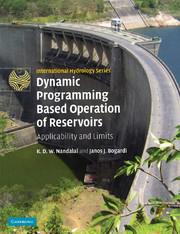Book contents
- Frontmatter
- Contents
- List of figures
- List of tables
- Preface
- 1 Water resources management
- 2 Incremental dynamic programming in optimal reservoir operation
- 3 Stochastic dynamic programming in optimal reservoir operation
- 4 Optimal reservoir operation for water quality
- 5 Large-scale reservoir system operation
- 6 Optimal reservoir operation for flood control
- References
- Index
4 - Optimal reservoir operation for water quality
Published online by Cambridge University Press: 14 August 2009
- Frontmatter
- Contents
- List of figures
- List of tables
- Preface
- 1 Water resources management
- 2 Incremental dynamic programming in optimal reservoir operation
- 3 Stochastic dynamic programming in optimal reservoir operation
- 4 Optimal reservoir operation for water quality
- 5 Large-scale reservoir system operation
- 6 Optimal reservoir operation for flood control
- References
- Index
Summary
When a flowing river is dammed and becomes an impoundment, two major changes occur. First, creating an impoundment greatly increases the time required for water to travel the distance from the headwaters to the discharge at the dam. Second, thermal or density and therefore chemical stratification may take place. Both have a marked effect on water quality. Both the increased detention time and thermal stratification in an impoundment change the characteristics of the water discharged at a given geographical location from what they were when the stream was free flowing. Some effects of impoundments improve water quality; others deteriorate it. This also implies the possibility of using the reservoirs for control of the quality of water besides merely satisfying the quantity requirement.
The increased emphasis on water quality accents the need for formulation of methodologies for operating reservoirs for control of water quality. Considering reservoir dynamics while applying optimization techniques for operational decisions enables policies for a reservoir accounting for the quality of water supplied besides satisfying quantity requirements. The assumption of complete instantaneous mixing of water in a reservoir throughout its entire volume is an over-simplification compared to the real behavior of reservoirs that undergo mixing and stratification cycles. This chapter presents models that assume complete mixing in reservoirs while deriving optimum operation policies when quality aspects are of interest.
There have been relatively few studies of optimum reservoir operation in which water quality has been considered.
- Type
- Chapter
- Information
- Dynamic Programming Based Operation of ReservoirsApplicability and Limits, pp. 59 - 72Publisher: Cambridge University PressPrint publication year: 2007



